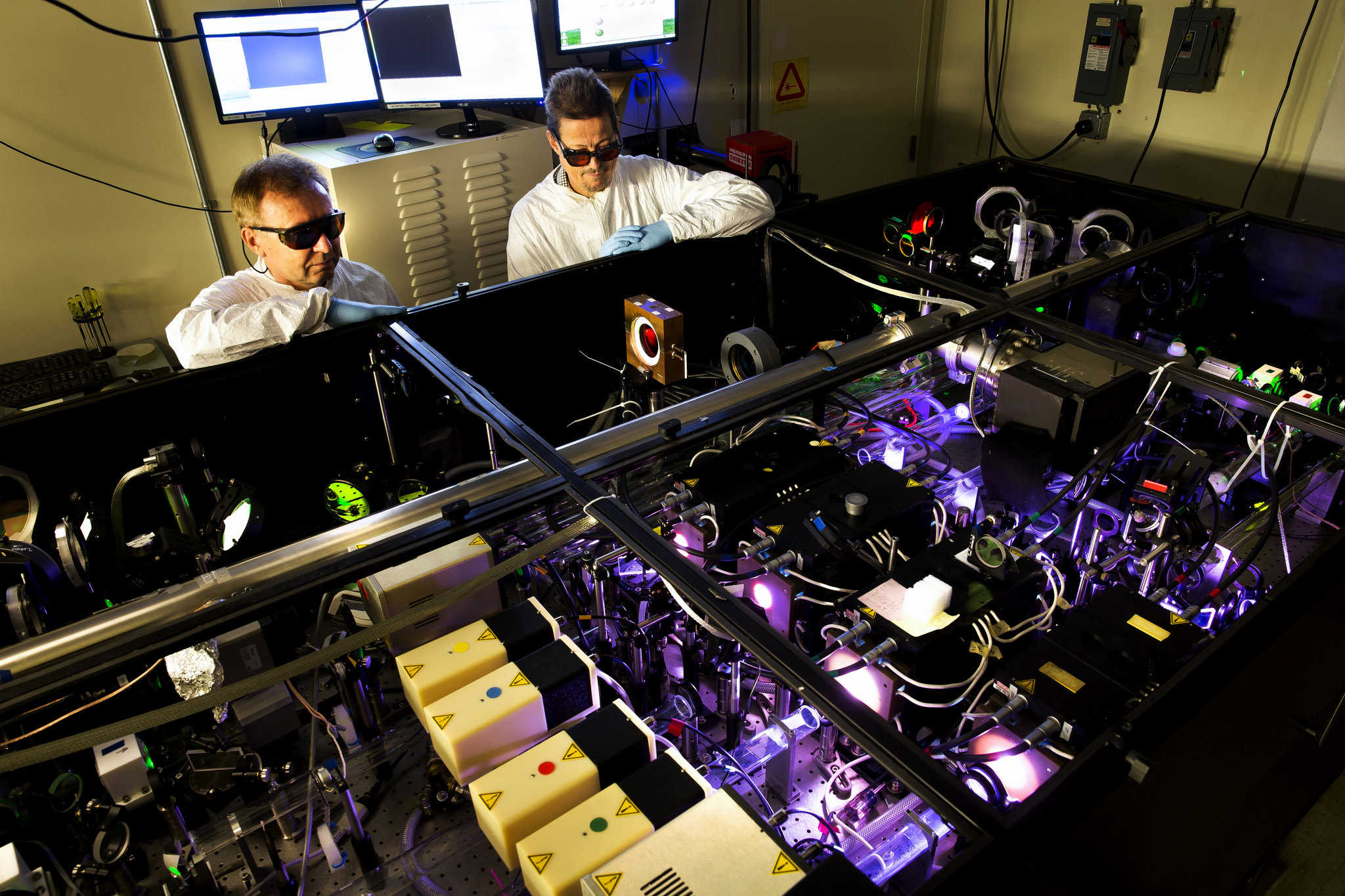U-M to become Mount Olympus with ZEUS, the most powerful laser to be built in the U.S.
The three-petawatt system could unlock secrets of the universe, advance cancer treatments, improve security screenings for nuclear threats, and much more.

 Enlarge
Enlarge
It will be the most powerful laser system in the United States.
Faculty affiliated with the Gérard Mourou Center for Ultrafast Optical Science (CUOS) are leading the design and creation of the Zettawatt-Equivalent Ultrashort pulse laser System (ZEUS), a three-petawatt system that will be one of the most advanced particle accelerators in the world. Prof. Karl Krushelnick is the project director, and Prof. Alexander Thomas helped originate the overall project concept.
“The thing that most excites me is that we will be able to accelerate an electron beam to energies similar to those in kilometer-scale particle accelerators,” Thomas said. “These beams could easily penetrate through a dense concrete block, but we can stop the same beam by colliding it with a mere hair’s breadth of laser light. In doing so, we will create lots of antimatter/matter, which could provide novel sources for scientific experiments and advanced technologies.”
The University of Michigan’s current most powerful and intense laser is HERCULES, which is a mere 0.5 petawatt system, or 500 terawatts. In comparison, the entire electrical grid of the U.S. operates on only one 1 terawatt of power.
While HERCULES held the title of World’s Most Intense Laser System for over a decade, other countries have taken the lead in developing more advanced laser systems. ZEUS is a chance for the U.S. to get back on the forefront of research that could further our understanding of the universe, advance cancer treatments, improve security screenings for nuclear threats, and much more.
“The amount of hardcore physics that we’ve been able to do has been a little bit limited by the intensity of our current laser systems,” says John Nees, an ECE Associate Research Scientist and one of the chief designers of ZEUS. “Upgrading from the HERCULES level to the ZEUS level puts us at a place where we can have very, very strong interactions between the laser light and the particles that the laser accelerates.”
Upgrading from the HERCULES level to the ZEUS level puts us at a place where we can have very, very strong interactions between the laser light and the particles that the laser accelerates.
John Nees
Another chief designer of ZEUS is Dr. Anatoly Maksimchuk, a Research Scientist, who says that one of the biggest challenges to designing a laser like this is that mistakes are costly. Damage to optical elements can be extremely expensive to fix and may delay the entire project. Patience during the design and building process is crucial.
“In the past, people tried to hurry and started with the highest power, basically damaging the system from the beginning to the end,” Maksimchuk says. “So, you don’t want to do that. You have to increase the power steadily so there are no mistakes.”
Systems like ZEUS can operate on such high power because the laser pulses are extremely short. They travel only ten microns in the span of 30 femtoseconds – the width of a human hair is about 70 microns, and a femtosecond is one quadrillionth of a second. The laser pulse is focused in a diffraction limited spot size of about one micron on a solid target. The light pressure that is generated during this process is only otherwise found in the interior of stars.
In addition to the higher power, ZEUS will also have a significant increase in intensity, which is important for the success of many experiments.
“The quality of the beam actually makes quite a big difference to the type of research that we can do,” says Prof. Louise Willingale, a co-PI who will eventually use ZEUS for her research. “A high-quality beam lets us focus it to the smallest area possible, which will give us the best, highest intensities.”
There are many research applications, such as exploring the influence of quantum electrodynamics – the reigning explanation of how the universe operates at the subatomic level – on plasma physics, as well as the potential to advance cancer treatments and medical imaging. What’s more, CUOS will operate as a National Science Foundation facility, so outside researchers from all over the world will be invited to work on ZEUS.
“It’s exciting for the students and our research here, because we’ll have so much cross-pollination with people bringing in their ideas,” says Willingale. “We’re hoping it will ensure U-M continues to be a hub for this type of research in the U.S.”
We're hoping it will ensure U-M continues to be a hub for this type of research in the U.S.
Prof. Louise Willingale
Like HERCULES, ZEUS will be housed in the Gérard Mourou Center for Ultrafast Optical Science on North Campus. Mourou, the A. D. Moore Distinguished University Professor Emeritus of ECE and former Director of CUOS, received the 2018 Noble Prize in Physics along with his former student, Prof. Donna Strickland from the University of Waterloo, for their method of generating high-intensity, ultra-short optical pulses known as “chirped pulse amplification.” Chirped pulse amplification led to the development of the safer, bladeless version of LASIK eye surgery, which tens of millions of people worldwide benefit from today. Mourou refined much of that technique during his nearly 20-year career at U-M, and ZEUS offers an opportunity for researchers to pursue the next great achievements in science.
For more information about the research applications, see the College of Engineering story
 MENU
MENU 
